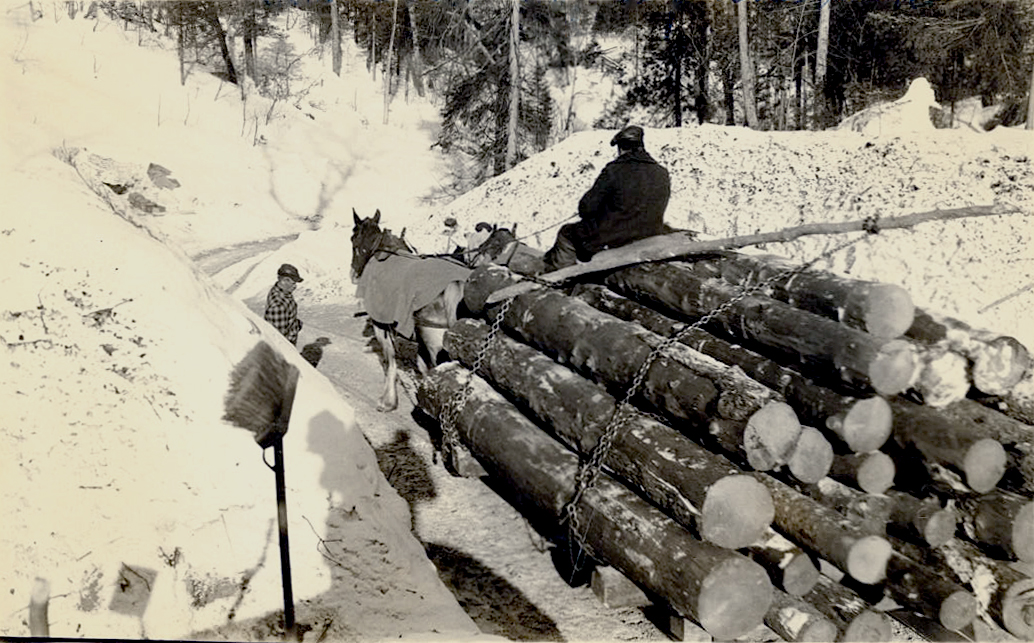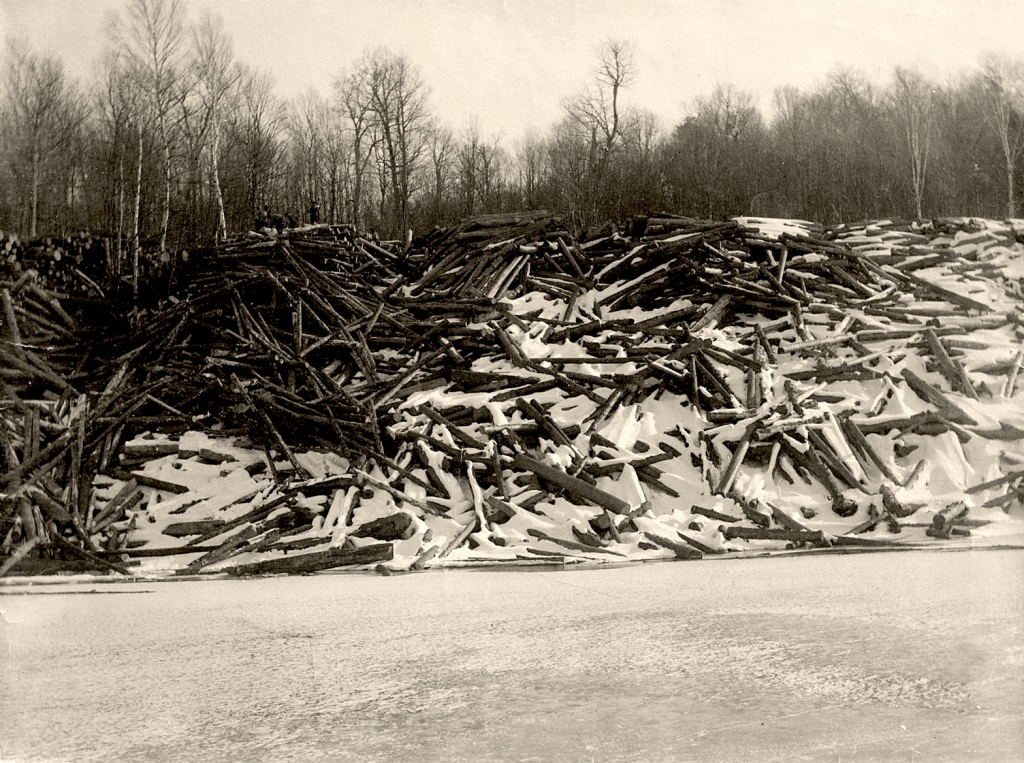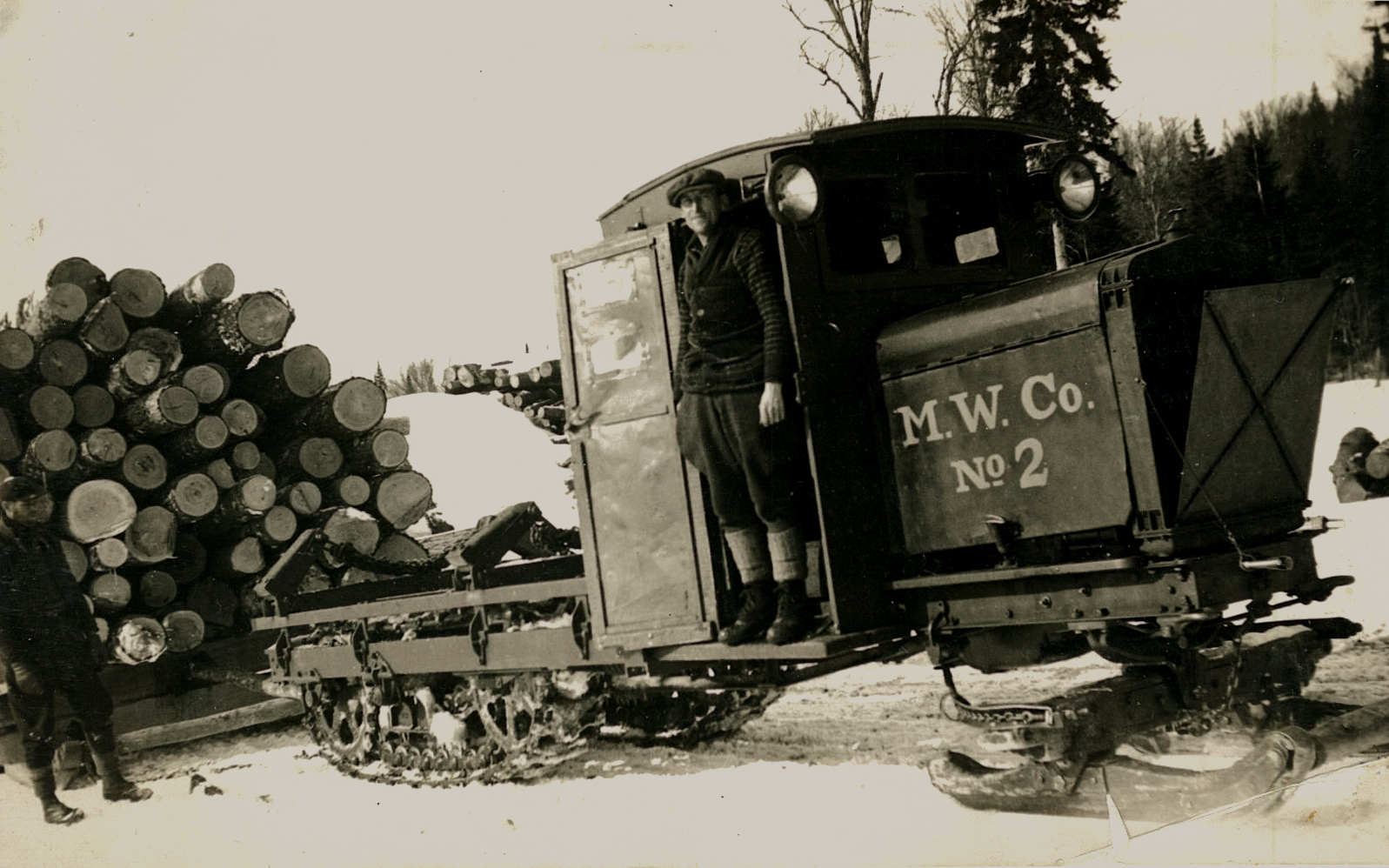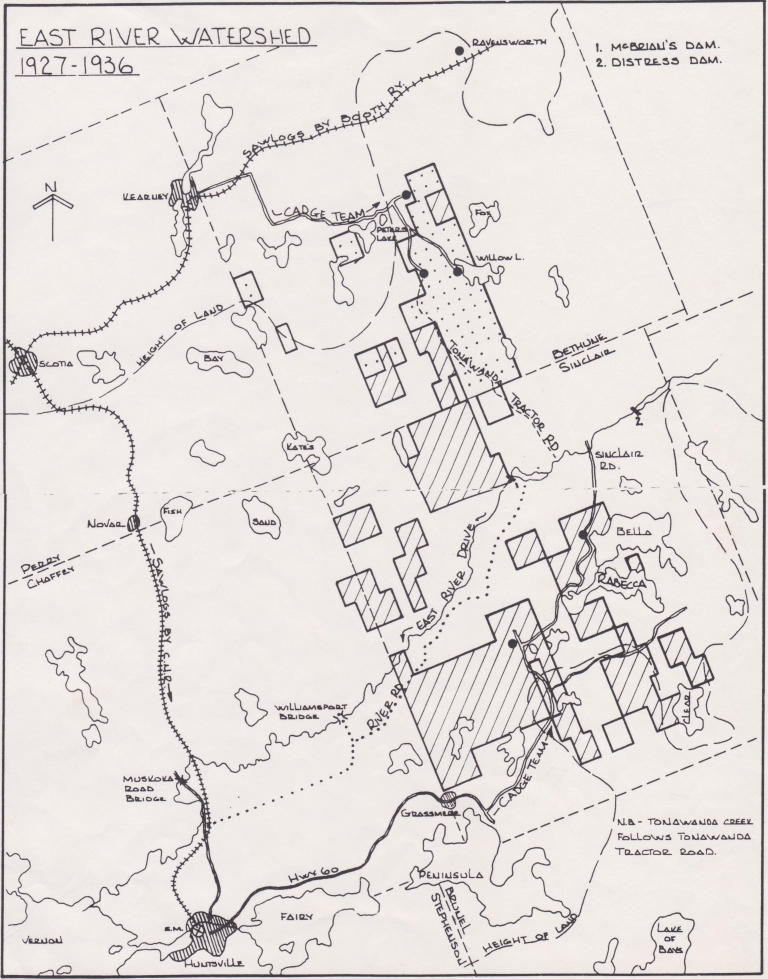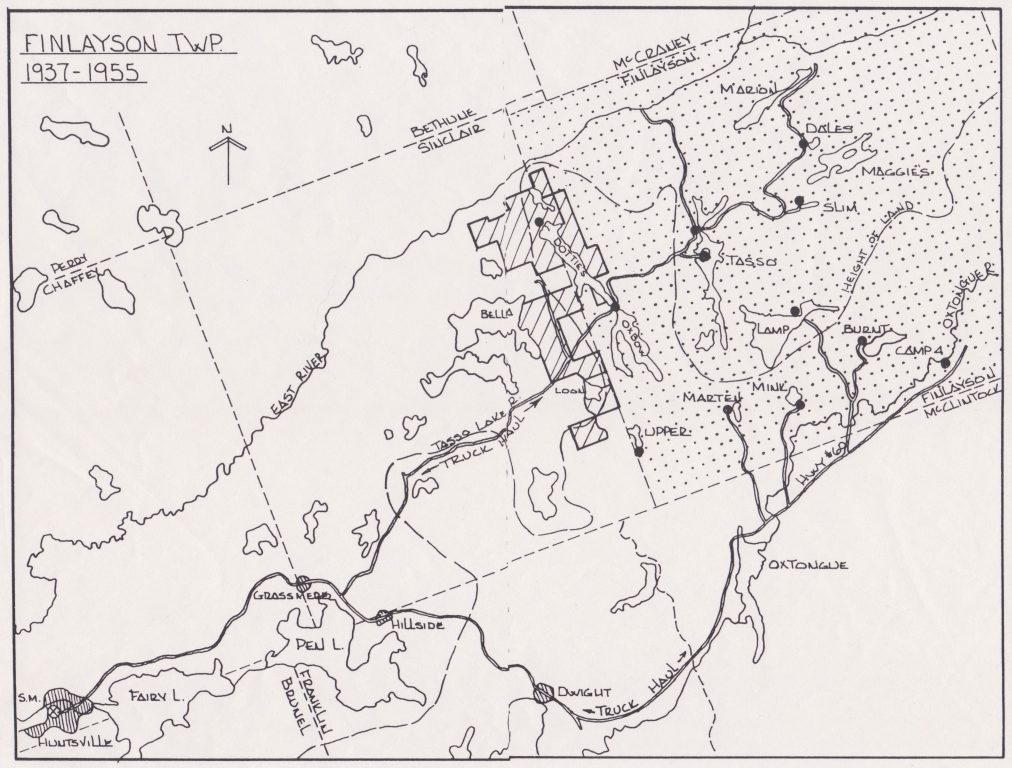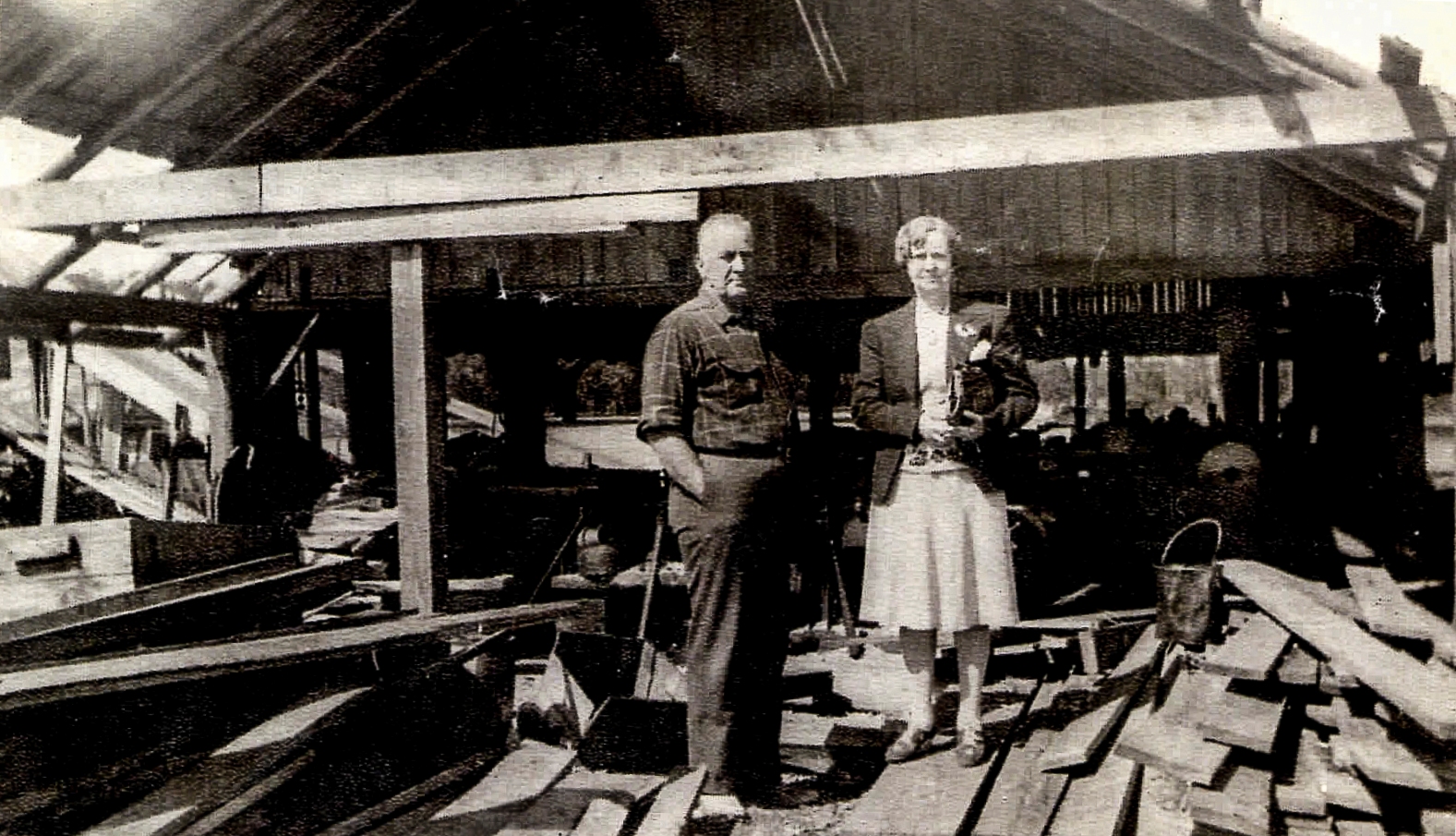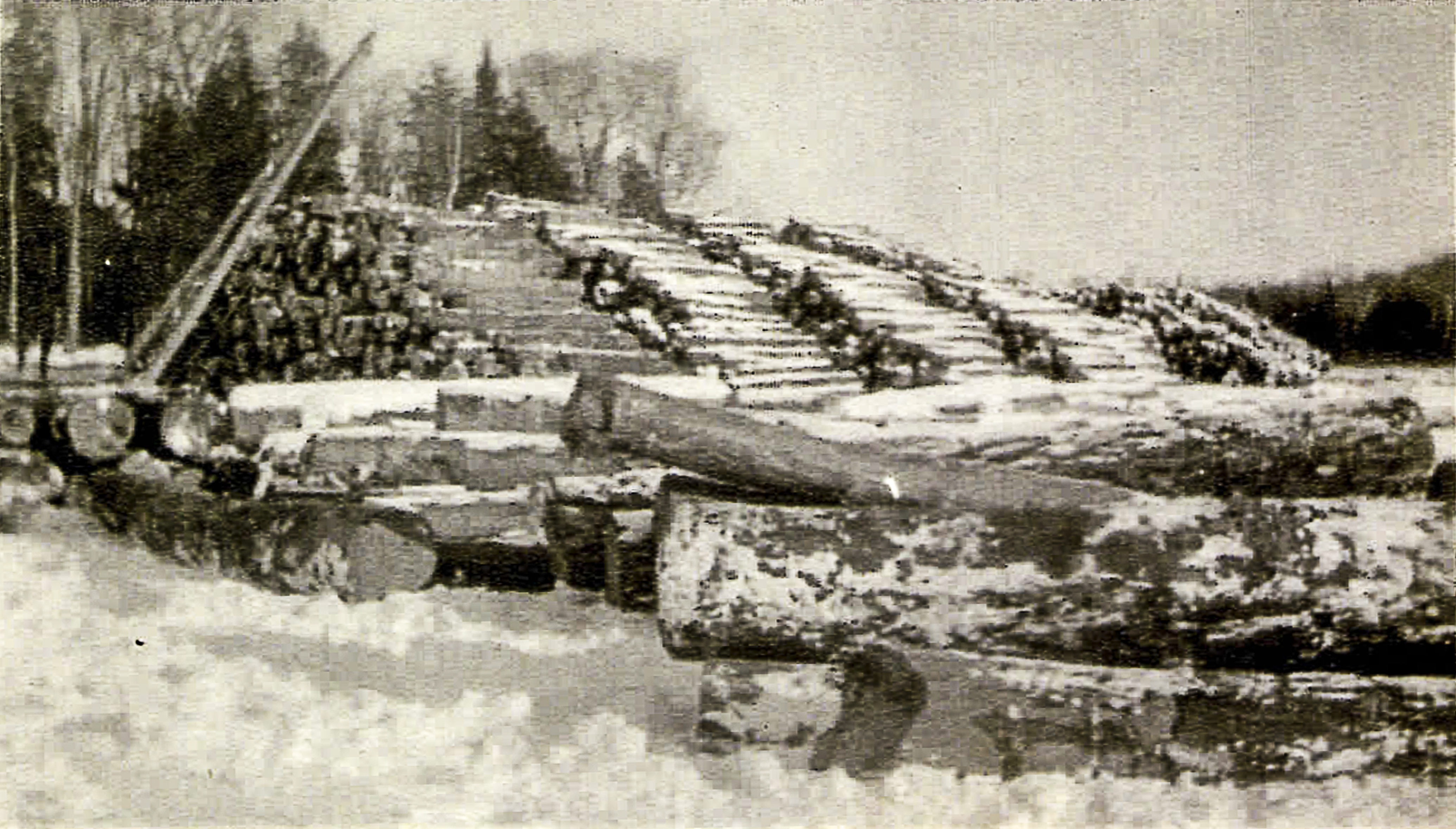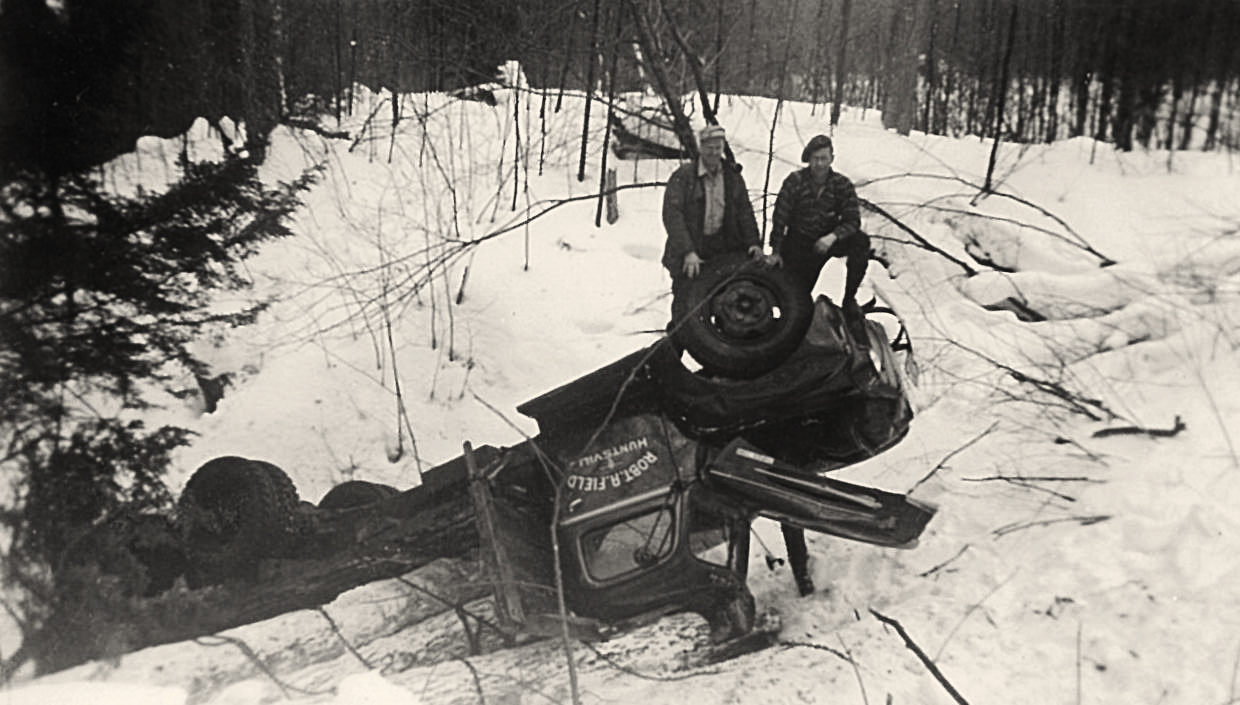Clearing Land and Local Logging
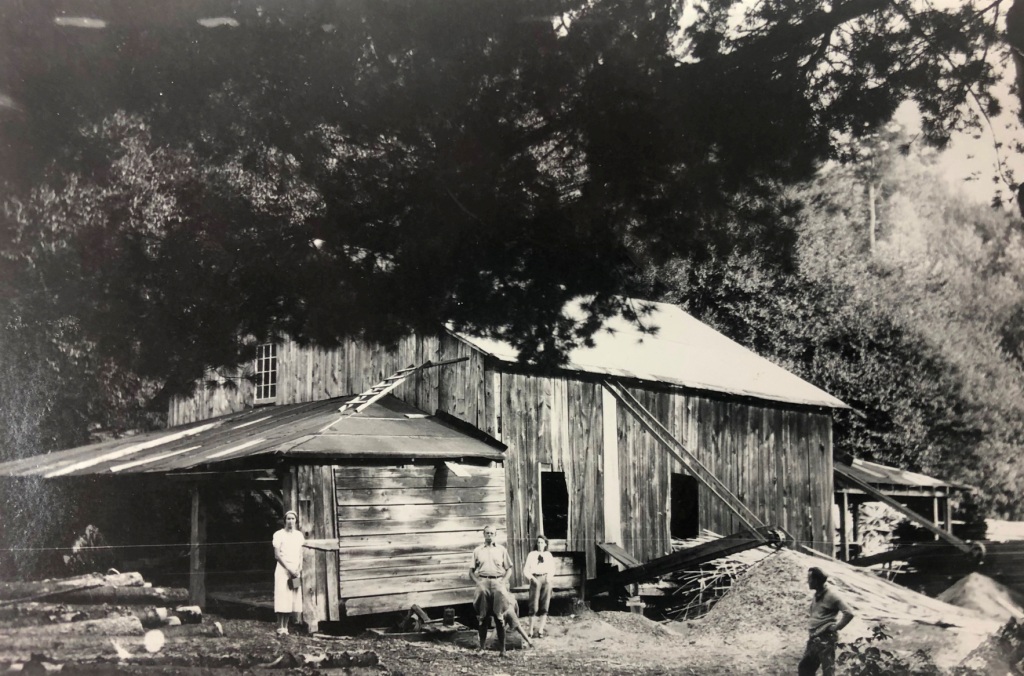 |
|
Walker’s Mill, 1933. The sawmill was built in 1876 and ran for more than 50 years. (Township of Lake of Bays, Barbara Paterson Papers, Box 4, Margaret Bowlby)
|
At the time that the survey was completed in 1876 for Sinclair Township, only local logging was done by the settlers themselves when they were clearing their lands, building their homes and barns, and making roads. The white pine could not be touched on their lots as it was owned by the Crown. Other than what was needed for building, much of the timber cut by the settlers was simply left to rot or was burned where it lay. Several settlers such as Robert Walker, who built a sawmill on Walker Lake, went directly into lumbering. There was no major market for any timber except the Crown-owned pine during this time, but even the pine was not removed from the Sinclair Township until after 1885.
By 1890, most of the settlers who had come to farm the land in Sinclair Township had moved away due to hardships, many to Manitoba. Only those who supplemented their living in the logging camps (or supplying food to the camps) were able to survive – lumbering in the winter and growing crops in the summer. Much of the abandoned farmland in Sinclair Township was purchased by the timber companies – and there was a lot of it.
Logging White Pine in Sinclair Township
As a result of the railway arriving in Huntsville in 1886, many pine companies and sawmills sprang up. Pine timber was cut and driven westwards on the East River into Lake Vernon to the sawmills in Huntsville and then headed south on the railway, mostly to the United States.
In most of Sinclair Township, including around Bella and Rebecca Lakes, there was not a lot of mature white pine except in the East River valleys. It was mixed with hardwood and other softwood. The pine was felled by two-man cross-cut saws (which replaced the timber axe), making what was called “saw logs” (pine with its bark still on), although some was still prepared as “squared timber.” Cross-cut saws were used right up to the 1950s, when they were replaced by two-man chainsaws.
River Driving on the East River, 1886-1936The East River flows westwards out of Algonquin Park to Lake Vernon, giving access to Huntsville. Pine was the only timber being driven on the river prior to the 1900s.This river was treacherous because of its rapids and rocky shores, and many mishaps occurred, some fatal. Lumber companies such as Brennen and Son and the Huntsville Lumber Company were sending pine down from Algonquin Park, plus it was coming from local townships within the East River watershed, including Sinclair. The pine companies built wooden dams such as Distress, McBrien, Tasso, and Finlayson Dams, among others, along the East River so that the water levels could be raised and lowered to assist the logging operations. Sometimes this resulted in flooding in Huntsville. The dams had to be rebuilt may times by the Big East River Improvement Company, which was operated by the lumbering companies using the river. After the 1900s hardwood and other softwoods were also sent down the river. There were usually two river drives – in the spring for softwood and some hardwoods and in August or later for the other hardwoods. There were logging camps all along the river. As many logging companies used the East River, each company used a stamp to mark its logs; when the logs reached Lake Vernon, they were sorted before being floated to the respective sawmills. The last drive on the East River was in the spring of 1936. In following years, lumber was trucked out by road. |
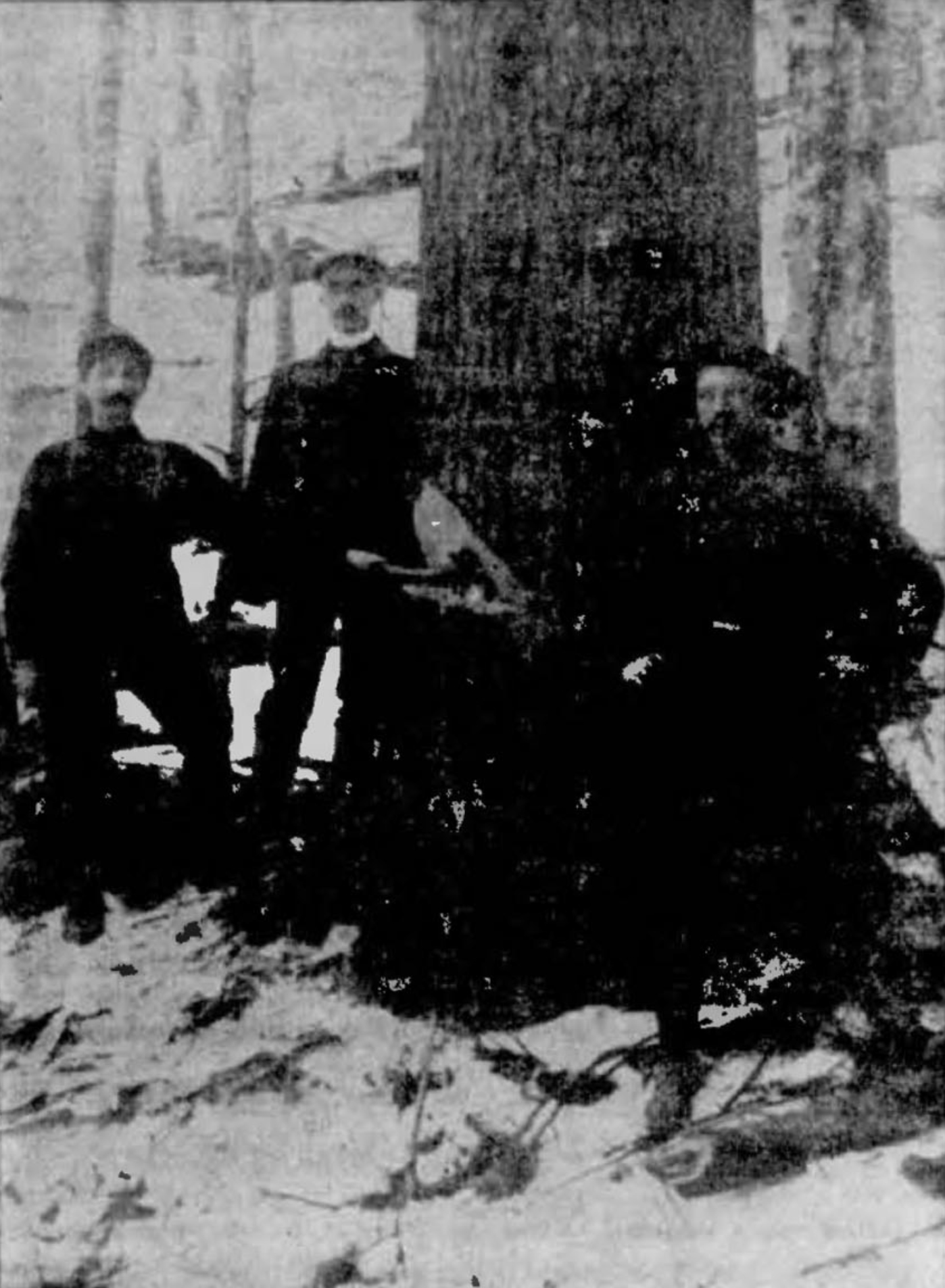 |
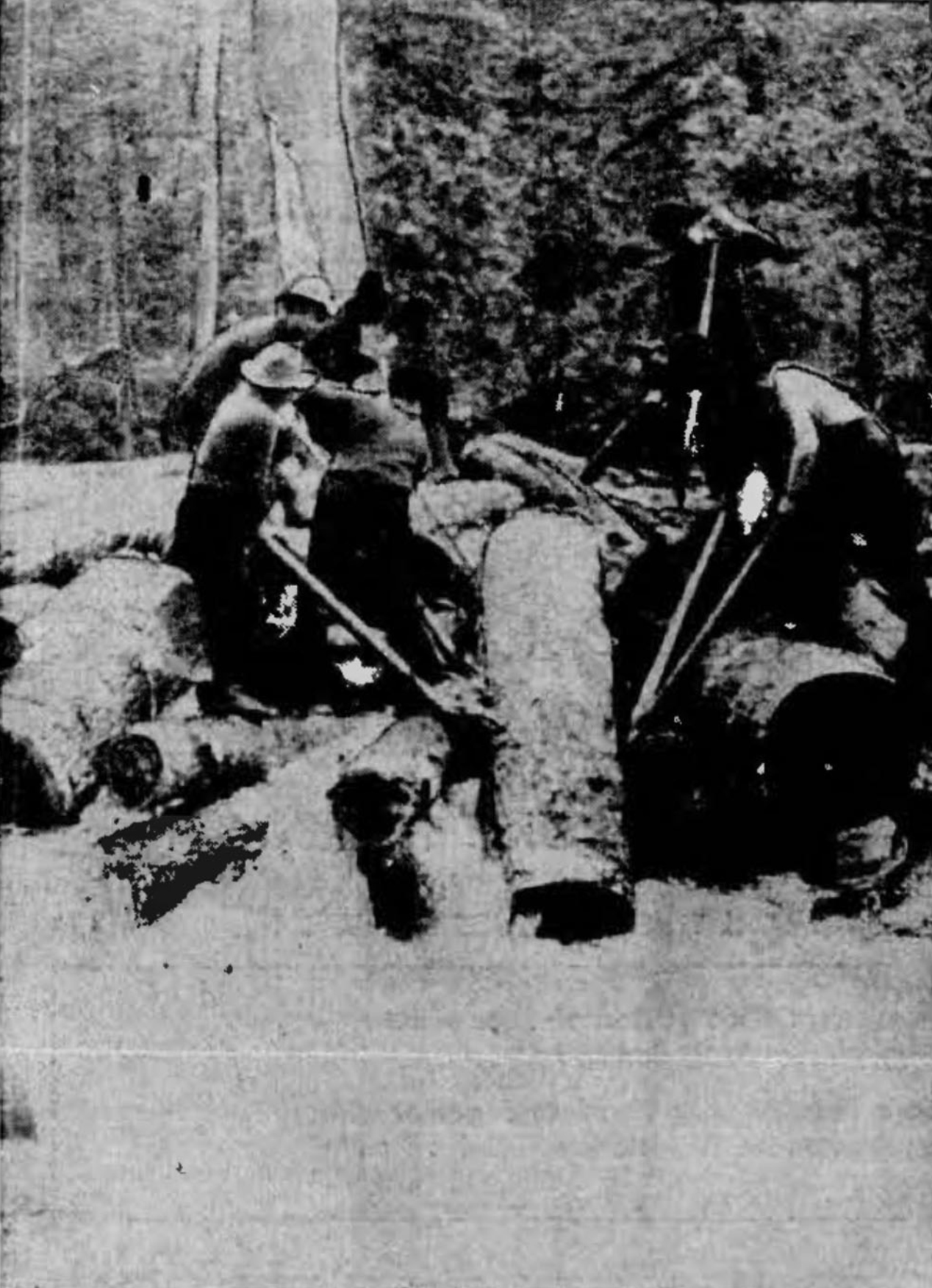 |
| Huntsville Lumber Company operations (Huntsville Forester) | Clearing a log jam on the East River (Huntsville Forester) |
J. Whiteside of the Riverside Lumber Company
John Whiteside went into the logging trade and set up a small mill in Huntsville in 1885. He logged pine in Sinclair and Bethune Townships. His mill was devastated by several fires. Later, Whiteside started purchasing lots in Sinclair for future hardwood cutting, and in 1907 he secured the Widdess and McAlister lots on Bella Lake. John Whiteside retired, and later his nephews, the Dinsmores, continued under the new name Bethune Pulp & Lumber with a mill in a different location.
Huntsville Lumber Company
The Heath, Tait & Turnbull Lumber Company (formed in 1886), became the Huntsville Lumber Company in 1892. It purchased other companies that lumbered on the Big East, such as Brennen and Son and the Whaley Lumber Company, and grew to become the largest lumber company in Huntsville. Acquiring extensive timber limits in Sinclair Township, the company started logging there around 1891. Pine was cut in the winter, skidded by horse teams to the East River, and placed out onto the ice, which would melt in the spring. The pine was driven down the river and floated to the company’s mill in Huntsville. This company was also driving pine from Algonquin Park.
James Bahen’s Sawmill, 1895-1904
James Bahen, a son of John Bahen Sr., was granted three lots in 1895 which he used only for lumbering (other than pine). He had a logging camp at the west end of a bay on Rebecca Lake, later named Hutcheson Bay, and a wooden dam at the mouth of Rebecca Creek to assist with the logging operations. James Bahen also built a small sawmill beside the creek, powered by water from a dug-out sluice channel, which he operated for approximately ten years. He also built a house there from his milled lumber. The sawmill is no longer there, and the house (a Hutcheson cottage) was rebuilt.
Hardwood Lumbering After 1900
A Dollar an AcreThe lumber companies would sometimes help settlers clear their lots as the settlers were under pressure to clear 15 acres within five years to receive their patent. The lumber companies offered the settlers $1 an acre (lots were worth 50 cents an acre) if they should ever have to leave and sell their farms. Many did and left for Manitoba. The lumber companies acquired a vast amount of land. Even in the 1950s the timberlands were still worth $1 an acre. |
After the Crown-owned pine was removed, hardwood logging began. Hardwood lumber companies began buying up settlers’ lots and moved into the Bella and Rebecca Lakes area around 1918. Yellow birch and hard maple were very abundant. Softwoods such as spruce were also cut at the same time. The Huntsville Lumber Company now began hardwood logging, but many other pine companies moved elsewhere. Rivers were still used for driving the logs until trucks started hauling logs after 1936.
A number of settlers, including the McBriens, Fields, and Hills, also set up their own logging companies as well as James Bahen. The Walker sawmill was still flourishing and operated for over 50 years, run by Robert Walker’s sons after the early 1900s. The mill closed in the 1930s.
The Huntsville Lumber Company had timber tracts in Sinclair Township, including the Hugh Fleming lots on the south shore of Bella Lake (after 1919). The company finally closed in 1929.
John Golden’s Logging Company owned lands and had timber contracts to lots in the area. John did extensive logging near the original Limberlost Road and the Loon Lake Hunt Camp in the early 1920s. He sold his lands to the Muskoka Wood Manufacturing Company.
Bethune Pulp & Lumber Company
After John Whiteside of Riverside Lumber died, his nephews Richard and Charles Dinsmore formed, with Sidney Davis, the Bethune Company and proceeded to log the Whiteside-owned lots for hardwood. These included the purchased McAlister and Widdess lots on the north shore of Bella Lake. In 1918 the Bethune Company set up its lumber camp on First Sandy towards the west end of the beach. The Bethune Company was also logging in the East River area, including Bear Creek, as well as in Bethune Township on Sinclair’s northern boundary.
Muskoka Wood Manufacturing Company
The Muskoka Wood Manufacturing Company was formed in Huntsville in 1902 by brothers Robert James Hutcheson and William E. Hutcheson, plus other shareholders, for the manufacturing of hardwood products. They purchased their mill on Hunters Bay from the Whaley Lumber Company. Hardwood was just starting to come on the market in the 1900s. It did not float in water and previously had to be sledded overland. R. J. Hutcheson discovered a way to make the logs float by removing the bark and letting them dry for several months.
As early as 1898, William and R. J. Hutcheson had begun buying up abandoned farm lots in many townships. They had acquired a lot of land over time – approximately 100,000 acres. In Sinclair Township they accumulated around 150 lots, totaling 14,000 acres. They also purchased logs from the settlers. As the Muskoka Wood Manufacturing Company was logging other townships first, they did not start in Sinclair until 1927.
William Hutcheson, who had purchased the James Bahen lots (Hutcheson Bay), sold his shares in the Muskoka Wood Manufacturing Company in 1921. During the 1920s, with his son George, he continued to remove timber in parts of Sinclair Township (and other townships) from various lots that he still owned, as well as working for other contractors. These were small operations, and William contracted to either of the two large mills in town to cut his wood – the Huntsville Lumber Company Mill and the Muskoka Wood Manufacturing Company Mill. R.J. Hutcheson and his sons Frank, Harry and Arther Hutcheson became the sole owners of Muskoka Wood Manufacturing Company.
Logging on Bella and Rebecca Lakes, 1927-1930
R. J. Hutcheson had several companies that owned land – one of these, Betula Forests Limited, had a considerable amount of land in Sinclair Township. (Betula lutea was the Latin name for yellow birch.) Muskoka Wood Manufacturing also had timber agreements for some lots. A large amount of this land was on the west side of Bella Lake (including the old Antioch post office site) and above and below Hutcheson Bay. R. J. Hutcheson had two logging camps on the Old Sinclair (Colonization) Road, which was used as a cadge team road for transporting supplies to the camps from Huntsville.
Tanbark from the Hemlock TreesBy 1890 tanning factories were starting to be established in Huntsville. Tannin for curing leather hides for shoes and harness was needed, and it came from the bark of hemlock trees. Hemlock was plentiful in Muskoka, growing in pure groves. In the early summer (June) the “Fellers” would fell the trees with cross-cut saws and the “Barkers” would immediately cut and peel four-foot long square sections of bark. These were dried and stacked. The bare hemlock logs were sent to the river for later driving. The bark was stacked high on sled trains to be pulled out during the winter and taken to Huntsville to the tanning factories. Lumber companies could easily supplement their logging operations with tanbark. Farmers could also collect and sell tanbark obtained from their own lots. |
The north logging camp was at Crawford’s Bay (also known as Lumberman’s Bay) on Bella Lake and was run by Clayton Johnson. In the 1980s there were still traces of an old log ramp into the water and a camp foundation. The south logging camp was at Bahen’s Clearing (north of Field’s Corners and west of Benson Lake) and was run by Noah Asgeirson. All that remained there was an old office, which was later used as a hunting cabin.
Hardwood and select softwood was skidded by horses in the winter over a myriad of iced trails to the shore of Distress Pond and various points downstream of the dam. Hardwood, with its bark peeled and drying, was piled high at an elevated area (log dump) by the shore of the river. Softwood was river driven in the spring, along with yellow birch. Other hardwoods such as hemlock were river driven in August or later. Muskoka Wood Manufacturing Company would first stamp an X on the ends of its logs so that they were easy to identify after the drive. From Lake Vernon they were floated by log boom across Hunters Bay to the Muskoka Wood Manufacturing Mill. The company was also involved in upgrading the dams that had been built by the earlier pine companies.
R. J. Hutcheson also had a large number of lots on the north side of the East River, which may have been logged at the same time as his Bethune Township operation in 1931-1936.
Both of R. J. Hutcheson’s lumber camps in Sinclair Township also produced large quantities of tanbark from the hemlock trees (for tanning leather), as a supplement to their hardwood cut. This usually paid for their entire logging operations. The dried tanbark was pulled on sled trains by a Lynn tractor over the ice across Bella Lake through to Rebecca Lake, into Hutcheson Bay, and then along the Old Sinclair Road down to Peninsula Lake and from there to Huntsville.
After 1936, timber was trucked out by road, and Lynn tractors replaced horses for the skidding of logs. Logging camps were generally no longer needed, and many became hunting camps.
Logging on the East Side of Bella Lake, 1937-1938
The Muskoka Wood Manufacturing Company logged the east side of Bella Lake, Loon Lake, and around Dotty Lake and the Bobcaygeon Road area in 1937, during R. J. Hutcheson’s Finlayson Township operation (which was completed by 1955, when Muskoka Wood was sold through another Company to Weldwood; it much later became Tembec). The company also had pine timber berths in Finlayson. All the timber was trucked out by road to Huntsville.
Hugh Hill’s Lumber Camps and Sawmill
In the mid-1930s Hugh Taylor Hill set up a lumber camp on the north shore of Bella Lake, in the same location of the old logging camp of Bethune Pulp & Lumber. These lots at this time belonged to Gordon Hill of Limberlost. During this period, the timber went to R. J. Hutcheson’s mill in Huntsville (Muskoka Wood Manufacturing). Hugh’s lumber camp was then moved to Limberlost in 1937 or 1938, as cottagers began to take up the subdivided lots along First Sandy beach and east around the point.
Soon after, Hugh Hill moved the lumber camp again, to Kells Landing (leased from the Kells) on Rebecca Lake. He set up a gasoline-powered sawmill there and operated it for a number of years, the timber coming from all around the general area. Sometimes, a small boom of several logs would be floated across both lakes and down to the sawmill. Logs were also piled where the Forrest cottage stands today. When spring would arrive, the logs were released into Rebecca Lake and floated across the Kells Bay to his sawmill to be cut. The logs were held in a boom until ready for cutting. After milling, the wood was taken by truck to Huntsville. The sawmill and lumber company was a major employer for the area. The logging camp with its many cabins made a very active community.
Brook’s Mill – Brookie, Lumberman and Road Builder
After several years of operating the sawmill, Hugh Hill went into partnership with Edgar Brook (Brookie), who later purchased Hugh’s share, and the sawmill became known as Brook’s Mill. Brookie’s wife, Mable Hart Brook, later purchased the property. Brookie lumbered in the area, plus his own lots (and those of his brother Fred) up at the East River. He had three lumber camps west of Bella Lake and up at the river. He built many logging roads, including the road along the side of Heck’s Lake up to the river. To truck his logs across the river, he built the first Sinclair Bridge. He also built the first bridge over the Narrows in 1949, to haul timber to his sawmill, as he logged several properties in the area west of Bella Lake. The sawmill burned down in 1952 and was rebuilt, this time powered by electricity. It ran for a few more years. The building is still there, but no longer running.
Robert A. Field
Robert Field was the youngest son of Henry Field, of Field’s Corners. He lost two older brothers in a tragic accident in 1915 at his father’s sawmill at Pell Lake. Robert was a lumberman in the family business (as well as a millwright) and logged his own lots between Bella and Rebecca Lakes in 1938 before building Fieldale Lodge and the Marina in 1942. He had Brookie build a road (Fieldale Road) for him so that he could truck his timber out.
Fire Ranger Bill Young
Bill Young was employed by the lumber companies. He stayed at the old Bethune lumber camp, later operated by Hugh Taylor Hill, at First Sandy on Bella Lake in the 1920s and 1930s. It was known as Old Bill’s Clearing. Bill Young would travel on foot all around the area and make daily visits to the fire tower located up a large hill beyond Heck’s Lake. He was always on the lookout for fires, which could devastate the landholdings of the lumber companies.
Reforestation in the 1940s
Hugh Hill and Edgar Brook (Brookie) planted red (Norway) pine at Second Sandy beach including Norway Point and various other locations in the Bella-Rebecca area in the 1930s-1940s. In the 1950s, the Muskoka Wood Manufacturing Company planted red pine on both sides of Billie Bear Road and everywhere there was a clearing. Some 200,000 red pines were planted.
Sources:
Bragg, Roger, "Muskoka Wood Manufacturing," East Georgian Bay Historical Journal, vol. 2 (1982), pp. 93-124
Cookson, Joe, Early Footsteps in Muskoka (Sprucedale: Olympic Printing, 1984).
Forrest, Billie, story in Barbara Paterson, Ruth Lehman, and Robin Sharp, eds., Pioneer Memorial Church: A Centennial History (Pioneer Memorial Church, 1992).
Hutcheson, Bob, notes and personal communication.
Hutcheson, G. F., Heads and Tales (Bracebridge: Herald-Gazette, 1972).
Mansell, W. Dan, Sunset Farm (Peterborough: asiOtus Natural Heritage Consultants, Barbara Paterson Papers and Mansell Heritage Series, 2012).
Ontario Ministry of Natural Resources, A Pictorial History of Algonquin Provincial Park (Toronto: Ministry of Natural Resources, 1978).
Pryke, Susan, Huntsville: With Spirit and Resolve (Huntsville: Fox Meadow Creations, 2000)




